19.1: Measuring Output Using GDP
- Last updated
- Save as PDF
- Page ID
- 3554

- Boundless
- Boundless
Defining GDP
Gross domestic product is the market value of all final goods and services produced within the national borders of a country for a given period of time.
learning agreements
- Distinguish between the income and expenditure approaches of assessing GDP
Gross domestic product (GDP) is the market value of all final goods and services produced within the national borders of a country for a given period of time. GDP can be determined in multiple ways. The income approach and the expenditure approach highlighted below should yield the same final GDP number.
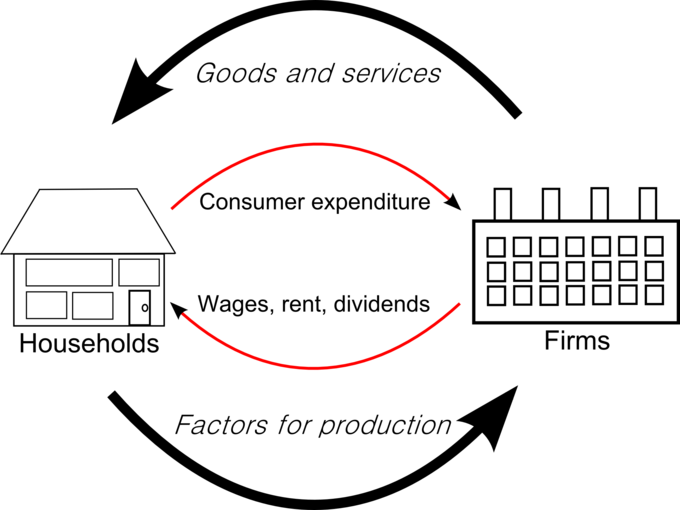
Simple view of expenditures: In an economy, households receive wages that they then use to purchase final goods and services. Since wages eventually are used in consumption (C), the expenditure approach to calculating GDP focuses on the end consumption expenditure to avoid double counting. The income approach, alternatively, would focus on the income made by households as one of its components to derive GDP.
Expenditure Approach
The expenditure approach attempts to calculate GDP by evaluating the sum of all final good and services purchased in an economy. The components of U.S. GDP identified as “Y” in equation form, include Consumption (C), Investment (I), Government Spending (G) and Net Exports (X – M).
\(\mathrm{Y = C + I + G + (X − M)}\) is the standard equational (expenditure) representation of GDP.
- “C” (consumption) is normally the largest GDP component in the economy, consisting of private expenditures (household final consumption expenditure) in the economy. Personal expenditures fall under one of the following categories: durable goods, non-durable goods, and services.
- “I” (investment) includes, for instance, business investment in equipment, but does not include exchanges of existing assets. Spending by households (not government) on new houses is also included in Investment. “Investment” in GDP does not mean purchases of financial products. It is important to note that buying financial products is classed as ‘ saving,’ as opposed to investment.
- “G” ( government spending ) is the sum of government expenditures on final goods and services. It includes salaries of public servants, purchase of weapons for the military, and any investment expenditure by a government. However, since GDP is a measure of productivity, transfer payments made by the government are not counted because these payment do not reflect a purchase by the government, rather a movement of income. They are captured in “C” when the payments are spent.
- “X” (exports) represents gross exports. GDP captures the amount a country produces, including goods and services produced for other nations’ consumption, therefore exports are added.
- “M” (imports) represents gross imports. Imports are subtracted since imported goods will be included in the terms “G”, “I”, or “C”, and must be deducted to avoid counting foreign supply as domestic.
Income Approach
The income approach looks at the final income in the country, these include the following categories taken from the U.S. “National Income and Expenditure Accounts”: wages, salaries, and supplementary labor income; corporate profits interest and miscellaneous investment income; farmers’ income; and income from non-farm unincorporated businesses. Two non-income adjustments are made to the sum of these categories to arrive at GDP:
- Indirect taxes minus subsidies are added to get from factor cost to market prices.
- Depreciation (or Capital Consumption Allowance) is added to get from net domestic product to gross domestic product.
Learning from GDP
GDP is a measure of national income and output that can be used as a comparison tool.
learning agreements
- Explain how GDP is calculated.
There are two commonly used measures of national income and output in economics, these include gross domestic product ( GDP ) and gross national product (GNP). These measures are focused on counting the total amount of goods and services produced within some “boundary” where the boundary is defined by either geography or citizenship.
Since GDP measures income and output, it can be used to compare two countries. The country with higher GDP is often regarded as wealthier, but, when using GDP to compare countries, it is important to remember to adjust for population.
GDP
GDP limits its focus to the value of goods or services in an actual geographic boundary of a country, where GNP is focused on the value of goods or services specifically attributable to citizens or nationality, regardless of where the production takes place. Over time GDP has become the standard metric used in national income reporting and most national income reporting and country comparisons are conducted using GDP.
GDP can be evaluated by using an output approach, income approach, or expenditure approach.
Output Approach
The output approach focuses on finding the total output of a nation by directly finding the total value of all goods and services a nation produces. Because of the complication of the multiple stages in the production of a good or service, only the final value of a good or service is included in the total output. This avoids an issue referred to as double counting, where the total value of a good is included several times in national output, by counting it repeatedly in several stages of production.
For example, in meat production, the value of the good from the farm may be $10, then $30 from the butchers, and then $60 from the supermarket. The value that should be included in final national output should be $60, not the sum of all those numbers, $90.
Formula: GDP (gross domestic product) at market price = value of output in an economy in the particular year – intermediate consumption at factor cost = GDP at market price – depreciation + NFIA (net factor income from abroad) – net indirect taxes.
Income Approach
The income approach equates the total output of a nation to the total factor income received by residents or citizens of the nation. The main types of factor income are:
- Employee compensation (cost of fringe benefits, including unemployment, health, and retirement benefits);
- Interest received net of interest paid;
- Rental income (mainly for the use of real estate) net of expenses of landlords;
- Royalties paid for the use of intellectual property and extractable natural resources.
All remaining value added generated by firms is called the residual or profit or business cash flow.
Formula: GDI (gross domestic income, which should equate to gross domestic product) = Compensation of employees + Net interest + Rental & royalty income + Business cash flow
Expenditure Approach
The expenditure approach is basically an output accounting method. It focuses on finding the total output of a nation by finding the total amount of money spent. This is acceptable, because like income, the total value of all goods is equal to the total amount of money spent on goods. The basic formula for domestic output takes all the different areas in which money is spent within the region, and then combines them to find the total output.
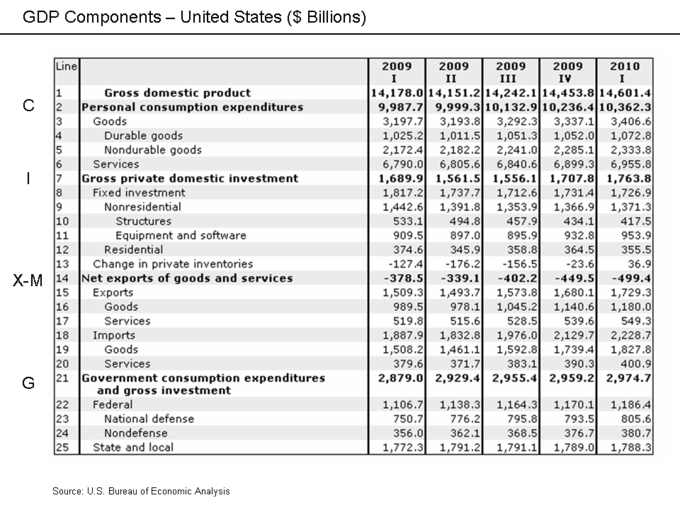
U.S. GDP Components: The components of GDP include consumption, investment, government spending, and net exports (exports minus imports).
Formula: \(\mathrm{Y = C + I + G + (X – M)}\); where: C = household consumption expenditures / personal consumption expenditures, I = gross private domestic investment, G = government consumption and gross investment expenditures, X = gross exports of goods and services, and M = gross imports of goods and services.
The Circular Flow and GDP
In economics, the “circular flow” diagram is a simple explanatory tool of how the major elements in an economy interact with one another.
learning agreements
- Evaluate the effect of the circular flow on GDP
In economics, the “circular flow” diagram is a simple explanatory tool of how the major elements as defined by the equation Y = Consumption + Investment + Government Spending + ( Exports – Imports). interact with one another. Circular flow is basically a continuous loop that for any point and time yields the value “Y” otherwise defined as the sum of final good and services in an economy, or gross domestic product ( GDP ).
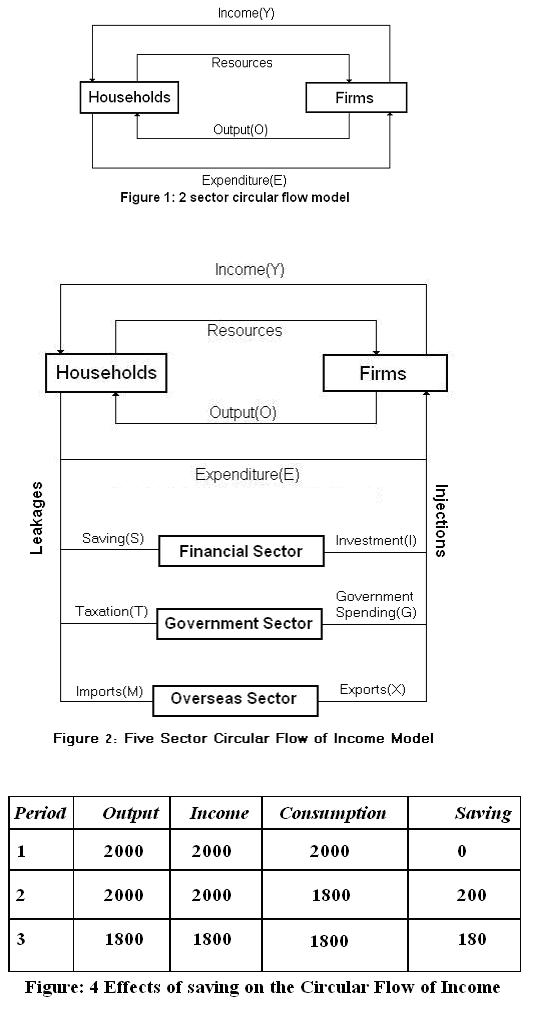
Circular flow: The circular flow is a simplified view of the economy that provides an ability to assess GDP at a specific point in time.
In the circular flow model, the household sector, provides various factors of production such as labor and capital, to producers who in turn produce goods and services. Firms compensate households for resource utilized and households pay for goods and services purchased from firms. This portion of the circular flow contributes to expenditures on consumption, C and generates income, which is the basis for savings (equal to investment) and government spending (tax revenue generated from income).
Investment, I, is equal to savings and is the income not spent but available to both consumers and firms for the purchase of capital investments, such as buildings, factories and homes. I represents an expenditure on investment capital.
Income generated in the relationship between firms and households is taxed and the remaining is either consumed and or saved. Government spending, G, is based on the tax revenue, T. G can be equal to taxes, less than or more than the tax revenue and represents government expenditure in the economy.
Finally, exports minus imports, X – M, references whether an economy is a net importer or exporter (or potentially trade neutral (X – M = 0)) and the impact of this component on overall GDP. Note that if the country is a net importer the value of X – M will be negative and will have a downward impact to overall GDP; if the country is a net exporter, the opposite will be true.
Circular flow
The continuous flow of production, income and expenditure is known as circular flow of income. It is circular because it has neither any beginning nor an end. The circular flow involves two basic assumptions:
1. In any exchange process, the seller or producer receives what the buyer or consumer spends.
2. Goods and services flow in one direction and money payment flow in the opposite or return direction, causing a circular flow.
GDP Equation in Depth (C+I+G+X)
GDP is the sum of Consumption (C), Investment (I), Government Spending (G) and Net Exports (X – M): \(\mathrm{Y = C + I + G + (X – M)}\).
learning agreements
- Identify the variables that make up GDP
Gross domestic product (GDP) is defined as the sum of all goods and services that are produced within a nation’s borders over a specific time interval, typically one calendar year.
Components of GDP
GDP (Y) is a sum of Consumption (C), Investment (I), Government Spending (G) and Net Exports (X – M):
\[\mathrm{Y=C+I+G+(X−M)}\]

Expenditure accounts: Components of the expenditure approach to calculating GDP as presented in the National Income Accounts (U.S. Bureau of Economic Analysis).
Defining the components
Consumption
Consumption (C) is normally the largest GDP component in the economy, consisting of private (household final consumption expenditure) in the economy. These personal expenditures fall under one of the following categories: durable goods, non-durable goods, and services. Examples include food, rent, jewelry, gasoline, and medical expenses but does not include the purchase of new housing. Also, it is important to note that goods such as hand-knit sweaters are not counted as part of GDP if they are gifted and not sold. Only expenditure based consumption is counted.
Investment
Investment (I) includes, for instance, business investment in equipment, but does not include exchanges of existing assets. Examples include construction of a new mine, purchase of software, or purchase of machinery and equipment for a factory. Spending by households (not government) on new houses is also included in Investment. In contrast to common usage, ‘Investment’ in GDP does not mean purchases of financial products. Buying financial products is classified as ‘ saving ‘, as opposed to investment. This avoids double-counting: if one buys shares in a company, and the company uses the money received to buy plant, equipment, etc., the amount will be counted toward GDP when the company spends the money on those things. To count it when one gives it to the company would be to count two times an amount that only corresponds to one group of products. Note that buying bonds or stocks is a swapping of deeds, a transfer of claims on future production, not directly an expenditure on products.
Government Spending
Government spending (G) is the sum of government expenditures on final goods and services. It includes salaries of public servants, purchase of weapons for the military, and any investment expenditure by a government. It does not include any transfer payments, such as social security or unemployment benefits.
Net Exports
Exports (X) represents gross exports. GDP captures the amount a country produces, including goods and services produced for other nations’ consumption, therefore exports are added.
Imports (M) represents gross imports. Imports are subtracted since imported goods will be included in the terms G, I, or C, and must be deducted to avoid counting foreign supply as domestic.
Sometimes, net exports is simply written as NX, but is the same thing as X-M.
Note that C, G, and I are expenditures on final goods and services; expenditures on intermediate goods and services do not count.
Calculating GDP
GDP can be calculated through the expenditures, income, or output approach.
learning agreements
- Identify the output approach to calculating GDP
Gross Domestic Product
Gross domestic product is one method of understanding a country’s income and allows for comparison to other countries.
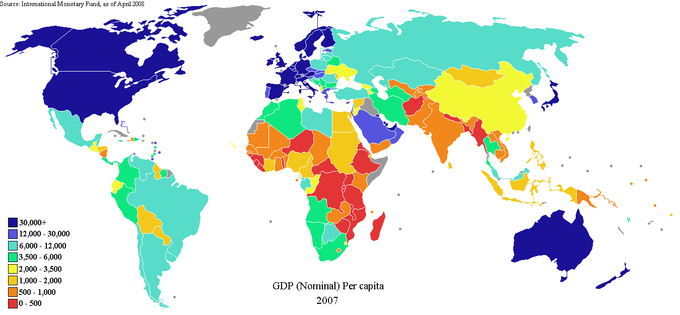
Global GDP: GDP is a common measure for both inter-country comparisons and intra-country comparisons. The metric is one method of understanding economic growth within a country’s borders.
By calculating the value of goods and services produced in a country, GDP provides a useful metric for understanding the economic momentum between the major factors of an economy: consumers, firms, and the government. There are a few methods used for calculating GDP, the most commonly presented are the expenditure and the income approach. Both of these methods calculate GDP by evaluating the final stage of sales (expenditure) or income (income). However, another approach referred to as the “output approach” calculates GDP by evaluating the value of all sales and adjusting for the purchase of intermediate goods (to remove double counting).
Expenditures Approach
The most well known approach to calculating GDP, the expenditures approach is characterized by the following formula:
\[\mathrm{GDP = C + I + G + (X-M)}\]
where C is the level of consumption of goods and services, I is gross investment, G is government purchases, X is exports, and M is imports.
Income Approach
The income approach adds up the factor incomes to the factors of production in the society. It can be expressed as:
\[\mathrm{GDP = \text{National Income (NY)} + \text{Indirect Business Taxes (IBT)} + \text{Capital Consumption Allowance and Depreciation (CCA)} + \text{Net Factor Payments to the rest of the world (NFP)}}\]
Output Approach
The output approach is also called “net product” or “value added” method. This method consists of three stages:
- Estimating the gross value of domestic output;
- Determining the intermediate consumption, i.e., the cost of material, supplies, and services used to produce final goods or services;
- Deducting intermediate consumption from gross value to obtain the net value of domestic output.
\[\text{Net value added} = \text{Gross value of output} – \text{Value of intermediate consumption.}\]
\[\text{Gross value of output} = \text{Value of the total sales of goods and services} + \text{Value of changes in the inventories.}\]
The sum of net value added in various economic activities is known as GDP at factor cost. GDP at factor cost plus indirect taxes less subsidies on products is GDP at producer price. GDP at producer price theoretically should be equal to GDP calculated based on the expenditure approach. However, discrepancies do arise because there are instances where the price that a consumer may pay for a good or service is not completely reflected in the amount received by the producer and the tax and subsidy adjustments mentioned above may not adequately adjust for the variation in payment and receipt.
Other Approaches to Calculating GDP
The income approach evaluates GDP from the perspective of the final income to economic participants.
learning agreements
- Explain the income approach to calculating GDP.
Gross domestic product provides a measure of the productivity of an economy specific to the national borders of a country. It can be measured a few different ways and the most commonly used metric is the expenditure approach; however, the second most commonly used measure is the income approach. The income approach unlike the expenditure approach, which sums the spending on final goods and services across economic agents (consumers, businesses and the government), evaluates GDP from the perspective of the final income to economic participants. GDP calculated in this manner is sometimes referenced as “Gross Domestic Income” (GDI).
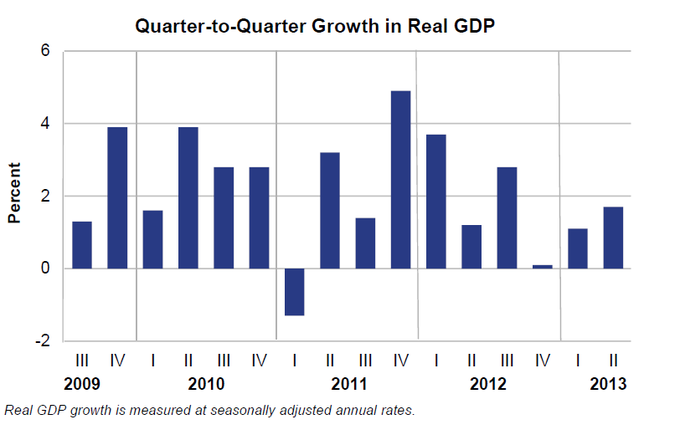
GDP over time: GDP is measured over consecutive periods to enable policymakers and economic agents to evaluate the state of the economy to set expectations and make decisions.
This method measures GDP by adding incomes that firms pay households for factors of production they hire- wages for labor, interest for capital, rent for land, and profits for entrepreneurship. The U.S. “National Income and Expenditure Accounts” divide incomes into five categories:
- Wages, salaries, and supplementary labor income
- Corporate profits
- Interest and miscellaneous investment income
- Farmers’ income
- Income from non-farm unincorporated businesses
Two adjustments must be made to get the GDP: Indirect taxes minus subsidies are added to get from factor cost to market prices. Depreciation (or Capital Consumption Allowance) is added to get from net domestic product to gross domestic product.
Income Approach Formula
GDP = compensation of employees + gross operating surplus + gross mixed income + taxes less subsidies on production and imports. Alternatively, this can be expressed as:
\[\mathrm{GDP = COE + GOS + GMI + T_{P \& M} – S_{P \& M}}\]
- Compensation of employees (COE) measures the total remuneration to employees for work done.
- Gross operating surplus (GOS) is the surplus due to owners of incorporated businesses.
- Gross mixed income (GMI) is the same measure as GOS, but for unincorporated businesses. This often includes most small businesses.
- TP & M is taxes on production and imports.
- SP&M is subsidies on production and imports.
The sum of COE, GOS, and GMI is called total factor income; it is the income of all of the factors of production in society. It measures the value of GDP at factor (basic) prices. The difference between basic prices and final prices (those used in the expenditure calculation) is the total taxes and subsidies that the government has levied or paid on that production. So, adding taxes less subsidies on production and imports converts GDP at factor cost (as noted, a net domestic product) to GDP.
By definition, the income approach to calculating GDP should be equatable to the expenditure approach \(\mathrm{(Y = C + I+ G + (X – M))}\). In practice, however, measurement errors will make the two figures slightly off when reported by national statistical agencies.
Evaluating GDP as a Measure of the Economy
The value of GDP as a measure of the quality of life for a given country may be limited.
learning agreements
- Assess the uses and limitations of GDP as a measure of the economy
Gross domestic product (GDP) due to its relative ease of calculation and definition, has become a standard metric in the discussion of economic welfare, growth and prosperity. However, the value of GDP as a measure of the quality of life for a given country may be quite poor given that the metric only provides the total value of production for a specific time interval and provides no insight with respect to the source of growth or the beneficiaries of growth. Therefore, growth could be misinterpreted by looking at GDP values in isolation.
Limitations of GDP
Simon Kuznets, the economist who developed the first comprehensive set of measures of national income, stated in his first report to the US Congress in 1934, in a section titled “Uses and Abuses of National Income Measurements”:
“Economic welfare cannot be adequately measured unless the personal distribution of income is known. And no income measurement undertakes to estimate the reverse side of income, that is, the intensity and unpleasantness of effort going into the earning of income. The welfare of a nation can, therefore, scarcely be inferred from a measurement of national income. ”
Following on his caution with respect to economic extrapolations from GDP, in 1962, Kuznets stated: “Distinctions must be kept in mind between quantity and quality of growth, between costs and returns, and between the short and long run. Goals for more growth should specify more growth of what and for what. ”
The sensitivities related to social welfare has continued the argument specific to the use of GDP as a economic growth or progress metric.
Austrian School economist Frank Shostak has noted: “The GDP framework cannot tell us whether final goods and services that were produced during a particular period of time are a reflection of real wealth expansion, or a reflection of capital consumption. For instance, if a government embarks on the building of a pyramid, which adds absolutely nothing to the well-being of individuals, the GDP framework will regard this as economic growth. In reality, however, the building of the pyramid will divert real funding from wealth-generating activities, thereby stifling the production of wealth.”
GDP as an Evaluation Metric
Although GDP provides a single quantitative metric by which comparisons can be made across countries, the aggregation of elements that create the single value of GDP provide limitations in evaluating a country and its economic agents. Given the calculation of the metric, a country with wide disparities in income could appear to be economically stronger than a country where the income disparities were significantly lower (standard of living). However, a qualitative assessment would likely value the latter country compared to the former on a welfare or quality of life basis.
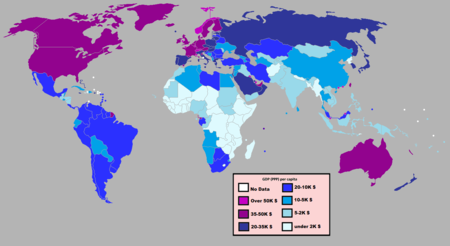
GDP across the globe: GDP can be adjusted to compare the purchasing power across countries but cannot be adjusted to provide a view of the economic disparities within a country.
Therefore, GDP has a tremendous big-picture value but policymakers would be better served using other metrics in combination with the aggregate measure if and when social welfare is being addressed.
Key Points
- GDP can be measured using the expenditure approach: \(\mathrm{Y = C + I + G + (X – M)}\).
- GDP can be determined by summing up national income and adjusting for depreciation, taxes, and subsidies.
- GDP can be determined in two ways, both of which, in principle, give the same result.
- The output approach focuses on finding the total output of a nation by directly finding the total value of all goods and services a nation produces.
- The income approach equates the total output of a nation to the total factor income received by residents or citizens of the nation.
- The expenditure approach is basically an output accounting method. It focuses on finding the total output of a nation by finding the total amount of money spent.
- In the circular flow model, the household sector, provides various factors of production such as labor and capital, to producers who in turn produce goods and services.
- Firms provide consumers with goods and services in exchange for consumer expenditure and “factors of production” from households.
- Investment is equal to savings and is the income not spent but available to both consumers and firms for the purchase of capital investments, such as buildings, factories and homes.
- A portion of income is also allocated to taxes (income is taxed and the remaining is either consumed and or saved); government spending, G, is based on the tax revenue, T.
- The continuous flow of production, income and expenditure is known as circular flow of income; it is circular because it has neither any beginning nor an end.
- C ( consumption ) is normally the largest GDP component in the economy, consisting of private (household final consumption expenditure ) in the economy.
- I ( investment ) includes, for instance, business investment in equipment, but does not include exchanges of existing assets.
- G ( government spending ) is the sum of government expenditures on final goods and services. It includes salaries of public servants, purchase of weapons for the military, and any investment expenditure by a government.
- X ( exports ) represents gross exports. GDP captures the amount a country produces, including goods and services produced for other nations’ consumption, therefore exports are added.
- M (imports) represents gross imports.
- The expenditures approach says GDP = consumption + investment + government expenditure + exports – imports.
- The income approach sums the factor incomes to the factors of production.
- The output approach is also called the “net product” or “value added” approach.
- The sum of COE, GOS, and GMI is called total factor income; it is the income of all of the factors of production in society. It measures the value of GDP at factor (basic) prices.
- Adding taxes less subsidies on production and imports converts GDP at factor cost (as noted, a net domestic product) to GDP.
- By definition, the income approach to calculating GDP should be equatable to the expenditure approach; however, measurement errors will make the two figures slightly off when reported by national statistical agencies.
- The sensitivities related to social welfare has continued the argument specific to the use of GDP as a economic growth or progress metric.
- A country with wide disparities in income could appear to be economically stronger, strictly using GDP, than a country where the income disparities were significantly lower (standard of living).
- Therefore, GDP has a tremendous big-picture value but policymakers would be better served using other metrics in combination with the aggregate measure if and when social welfare is being addressed.
Key Terms
- GDP: Gross domestic product (GDP) is the market value of all officially recognized final goods and services produced within a country in a given period of time.
- gross national product: The total market value of all the goods and services produced by a nation (citizens of a country, whether living at home or abroad) during a specified period.
- gross domestic product: A measure of the economic production of a particular territory in financial capital terms over a specific time period.
- Factors of production: In economics, factors of production are inputs. They may also refer specifically to the primary factors, which are stocks including land, labor, and capital goods applied to production.
- circular flow: A model of market economy that shows the flow of dollars between households and firms.
- government spending: Includes all government consumption, investment but excludes transfer payments made by a state.
- consumption: In the expenditure approach, the amount of goods and services purchased for consumption by individuals.
- export: Any good or commodity, transported from one country to another country in a legitimate fashion, typically for use in trade.
- import: To bring (something) in from a foreign country, especially for sale or trade.
- investment: A placement of capital in expectation of deriving income or profit from its use.
- expenditure approach: The total spending on all final goods and services (Consumption goods and services (C) + Gross Investments (I) + Government Purchases (G) + (Exports (X) – Imports (M)) \(\mathrm{GDP = C + I + G + (X-M)}\).
- income approach: GDP based on the income approach is calculated by adding up the factor incomes to the factors of production in the society.
- output approach: GDP is calculated using the output approach by summing the value of sales of goods and adjusting (subtracting) for the purchase of intermediate goods to produce the goods sold.
- depreciation: The measurement of the decline in value of assets. Not to be confused with impairment, which is the measurement of the unplanned, extraordinary decline in value of assets.
- qualitative: Based on descriptions or distinctions rather than on some quantity.
- welfare: Health, safety, happiness and prosperity; well-being in any respect.
- quantitative: Of a measurement based on some number rather than on some quality.
LICENSES AND ATTRIBUTIONS
CC LICENSED CONTENT, SPECIFIC ATTRIBUTION
- Gross domestic product. Provided by: Wikipedia. Located at: en.Wikipedia.org/wiki/Gross_domestic_product. License: CC BY-SA: Attribution-ShareAlike
- Gross domestic product. Provided by: Wikipedia. Located at: en.Wikipedia.org/wiki/Gross_d...ncome_approach. License: CC BY-SA: Attribution-ShareAlike
- GDP. Provided by: Wiktionary. Located at: en.wiktionary.org/wiki/GDP. License: CC BY-SA: Attribution-ShareAlike
- Provided by: Wikimedia. Located at: upload.wikimedia.org/wikipedi...ods_income.png. License: CC BY-SA: Attribution-ShareAlike
- gross domestic product. Provided by: Wiktionary. Located at: en.wiktionary.org/wiki/gross_domestic_product. License: CC BY-SA: Attribution-ShareAlike
- Measures of national income and output. Provided by: Wikipedia. Located at: en.Wikipedia.org/wiki/Measure...ome_and_output. License: CC BY-SA: Attribution-ShareAlike
- gross national product. Provided by: Wikipedia. Located at: en.Wikipedia.org/wiki/gross%2...onal%20product. License: CC BY-SA: Attribution-ShareAlike
- Provided by: Wikimedia. Located at: upload.wikimedia.org/wikipedi...ods_income.png. License: CC BY-SA: Attribution-ShareAlike
- Provided by: Wikimedia. Located at: upload.wikimedia.org/wikipedi...ted_States.png. License: Public Domain: No Known Copyright
- Circular flow of income. Provided by: Wikipedia. Located at: en.Wikipedia.org/wiki/Circular_flow_of_income. License: CC BY-SA: Attribution-ShareAlike
- Factors of production. Provided by: Wikipedia. Located at: en.Wikipedia.org/wiki/Factors...f%20production. License: CC BY-SA: Attribution-ShareAlike
- Boundless. Provided by: Boundless Learning. Located at: www.boundless.com//economics/.../circular-flow. License: CC BY-SA: Attribution-ShareAlike
- Provided by: Wikimedia. Located at: upload.wikimedia.org/wikipedi...ods_income.png. License: CC BY-SA: Attribution-ShareAlike
- Provided by: Wikimedia. Located at: upload.wikimedia.org/wikipedi...ted_States.png. License: Public Domain: No Known Copyright
- Provided by: Wikimedia. Located at: upload.wikimedia.org/wikipedi..._of_income.jpg. License: CC BY-SA: Attribution-ShareAlike
- Gross domestic product. Provided by: Wikipedia. Located at: en.Wikipedia.org/wiki/Gross_domestic_product. License: CC BY-SA: Attribution-ShareAlike
- export. Provided by: Wiktionary. Located at: en.wiktionary.org/wiki/export. License: CC BY-SA: Attribution-ShareAlike
- import. Provided by: Wiktionary. Located at: en.wiktionary.org/wiki/import. License: CC BY-SA: Attribution-ShareAlike
- consumption. Provided by: Wiktionary. Located at: en.wiktionary.org/wiki/consumption. License: CC BY-SA: Attribution-ShareAlike
- investment. Provided by: Wiktionary. Located at: en.wiktionary.org/wiki/investment. License: CC BY-SA: Attribution-ShareAlike
- government spending. Provided by: Wikipedia. Located at: en.Wikipedia.org/wiki/government%20spending. License: CC BY-SA: Attribution-ShareAlike
- Provided by: Wikimedia. Located at: upload.wikimedia.org/wikipedi...ods_income.png. License: CC BY-SA: Attribution-ShareAlike
- Provided by: Wikimedia. Located at: upload.wikimedia.org/wikipedi...ted_States.png. License: Public Domain: No Known Copyright
- Provided by: Wikimedia. Located at: upload.wikimedia.org/wikipedi..._of_income.jpg. License: CC BY-SA: Attribution-ShareAlike
- Provided by: Wikimedia. Located at: upload.wikimedia.org/wikipedi...ted_States.png. License: Public Domain: No Known Copyright
- Gross domestic product. Provided by: Wikipedia. Located at: en.Wikipedia.org/wiki/Gross_domestic_product. License: CC BY-SA: Attribution-ShareAlike
- Measuring GDP. Provided by: Wikipedia. Located at: en.Wikipedia.org/wiki/Measuring_GDP. License: CC BY-SA: Attribution-ShareAlike
- expenditure approach. Provided by: Wikipedia. Located at: en.Wikipedia.org/wiki/expenditure%20approach. License: CC BY-SA: Attribution-ShareAlike
- output approach. Provided by: Wikipedia. Located at: en.Wikipedia.org/wiki/output%20approach. License: CC BY-SA: Attribution-ShareAlike
- income approach. Provided by: Wikipedia. Located at: en.Wikipedia.org/wiki/income%20approach. License: CC BY-SA: Attribution-ShareAlike
- Provided by: Wikimedia. Located at: upload.wikimedia.org/wikipedi...ods_income.png. License: CC BY-SA: Attribution-ShareAlike
- Provided by: Wikimedia. Located at: upload.wikimedia.org/wikipedi...ted_States.png. License: Public Domain: No Known Copyright
- Provided by: Wikimedia. Located at: upload.wikimedia.org/wikipedi..._of_income.jpg. License: CC BY-SA: Attribution-ShareAlike
- Provided by: Wikimedia. Located at: upload.wikimedia.org/wikipedi...ted_States.png. License: Public Domain: No Known Copyright
- GDP nominal per capita world map IMF 2007. Provided by: Wikipedia. Located at: en.Wikipedia.org/wiki/File:GD...p_IMF_2007.PNG. License: CC BY: Attribution
- Gross domestic product. Provided by: Wikipedia. Located at: en.Wikipedia.org/wiki/Gross_d...ncome_approach. License: CC BY-SA: Attribution-ShareAlike
- Gross domestic product. Provided by: Wikipedia. Located at: en.Wikipedia.org/wiki/Gross_d...ncome_approach. License: CC BY-SA: Attribution-ShareAlike
- expenditure approach. Provided by: Wikipedia. Located at: en.Wikipedia.org/wiki/expenditure%20approach. License: CC BY-SA: Attribution-ShareAlike
- income approach. Provided by: Wikipedia. Located at: en.Wikipedia.org/wiki/income%20approach. License: CC BY-SA: Attribution-ShareAlike
- depreciation. Provided by: Wiktionary. Located at: en.wiktionary.org/wiki/depreciation. License: CC BY-SA: Attribution-ShareAlike
- Provided by: Wikimedia. Located at: upload.wikimedia.org/wikipedi...ods_income.png. License: CC BY-SA: Attribution-ShareAlike
- Provided by: Wikimedia. Located at: upload.wikimedia.org/wikipedi...ted_States.png. License: Public Domain: No Known Copyright
- Provided by: Wikimedia. Located at: upload.wikimedia.org/wikipedi..._of_income.jpg. License: CC BY-SA: Attribution-ShareAlike
- Provided by: Wikimedia. Located at: upload.wikimedia.org/wikipedi...ted_States.png. License: Public Domain: No Known Copyright
- GDP nominal per capita world map IMF 2007. Provided by: Wikipedia. Located at: en.Wikipedia.org/wiki/File:GD...p_IMF_2007.PNG. License: CC BY: Attribution
- Provided by: Wordpress. Located at: http://docbea.files.wordpress.com/20.../731_gdp_1.png. License: Public Domain: No Known Copyright
- Gross domestic product. Provided by: Wikipedia. Located at: en.Wikipedia.org/wiki/Gross_d...and_Criticisms. License: CC BY-SA: Attribution-ShareAlike
- welfare. Provided by: Wiktionary. Located at: en.wiktionary.org/wiki/welfare. License: CC BY-SA: Attribution-ShareAlike
- qualitative. Provided by: Wiktionary. Located at: en.wiktionary.org/wiki/qualitative. License: CC BY-SA: Attribution-ShareAlike
- quantitative. Provided by: Wiktionary. Located at: en.wiktionary.org/wiki/quantitative. License: CC BY-SA: Attribution-ShareAlike
- Provided by: Wikimedia. Located at: upload.wikimedia.org/wikipedi...ods_income.png. License: CC BY-SA: Attribution-ShareAlike
- Provided by: Wikimedia. Located at: upload.wikimedia.org/wikipedi...ted_States.png. License: Public Domain: No Known Copyright
- Provided by: Wikimedia. Located at: upload.wikimedia.org/wikipedi..._of_income.jpg. License: CC BY-SA: Attribution-ShareAlike
- Provided by: Wikimedia. Located at: upload.wikimedia.org/wikipedi...ted_States.png. License: Public Domain: No Known Copyright
- GDP nominal per capita world map IMF 2007. Provided by: Wikipedia. Located at: en.Wikipedia.org/wiki/File:GD...p_IMF_2007.PNG. License: CC BY: Attribution
- Provided by: Wordpress. Located at: http://docbea.files.wordpress.com/20.../731_gdp_1.png. License: Public Domain: No Known Copyright
- Provided by: Wikimedia. Located at: upload.wikimedia.org/wikipedi...dpercapita.PNG. License: Public Domain: No Known Copyright

